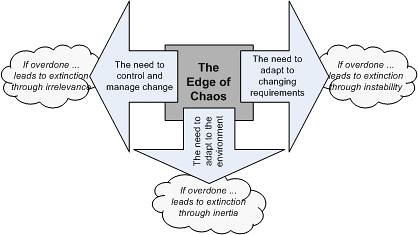Tool: The management of chaos
Topic: Enterprise Architecture and The Open Group Architecture Framework
When the famous architect, Christopher Wren, designed the Saint Paul’s Cathedral for London in 1673, he envisioned a monument to a single purpose that would remain unchanged for generations. Many software solutions have been built with the same end in mind and have become redundant within a single generation, due to the demands of a single requirement . . . unlike Cathedrals, technology solutions have to adapt to an environment in which there is constant change.
Technology solutions, therefore, must be more like eco-systems than traditional architectures. Eco-systems describe environments that evolve, meaning that they remain viable in the face of change and they strike a balance between flexibility, manageability and adaptability.
Anyone who has studied Complex Systems Theory will recognise the fact that the balance between flexibility, manageability and adaptability is a very fine line. It was defined by Langton in the 1980s, as The Edge of Chaos. The point where systems are:
- stable enough to remain viable, and yet
- adaptable enough to be spontaneous, adaptive, and alive.
Does all the current discussion in IT regarding agile computing come to mind here?
Successful complex systems tend to locate themselves at the edge of chaos, where there is sufficient innovation to keep the system vibrant, but enough stability to prevent a collapse into anarchy. Examples include companies operating in the marketplace, the human brain and (of course) an Enterprise Architecture.

In complex systems theory, turbulence is caused by the spontaneous interactions between parts of the system and the changing environment. It is this turbulence that creates the service interruptions that businesses struggle against each day, in both their competitive environment and their technology environment.
This was clearly demonstrated in early client/server systems which poured new technologies into the environment before the management tools and processes were in place, creating unpredictable imbalances in service and, in some cases, true chaos.
Warren G Bennis once said "The factory of the future will have only two employees: a man and a dog. The man will be there to feed the dog. The dog will be there to stop the man touching the computer." We clearly have a way to go yet. Most of today's computers have so may men touching them that forensic scientists dream of using them for fingerprint practice, and corporations are employing so many dogs that new service industries are appearing just to administer the leads.
In any modern enterprise Information Technology has become a complex eco-system, with the applications being used to support the business sitting along side the systems being used to monitor those applications, and all the time, the environment is clearly changing, both for the business and the technologies.
So what complex systems theory helps us to understand is that we could focus our efforts on:
- Flexibility, to the extent that our systems become unmanageable
- Control, to the extent that our systems cannot respond to new circumstances
- Change, to the extent that we fail to exploit successful models and patterns
IT professionals can use this information to reinforce a fundamental principle, that flexibility and adaptability must be balanced by visibility and manageability. In other words, we must wrap our eco-system within a framework of principles, governance and planning, as shown here:

Companies should select The Open Group Architecture Framework (TOGAF) because it provides a structured means of envisioning and describing the Enterprise Architecture plus the planning and governance required to ensure success during its implementation and operation.
TOGAF defines the deliverables (artefacts) of Enterprise Architecture as:
“the technical specification of all behaviour that goes on in an organization, the data that is processed, who does what, where everything is, and why everything is done”. It is therefore one of the tools you need to survive at the edge of chaos, along with strong governance processes and a commitment to an agile environment such as a true service oriented architecture.
This blog (with its various postings) provides a practical approach to making TOGAF work for you. I am usually involved in projects that are categorized by the Open Group as “top down planning” where the whole meta-enterprise is designed as a single entity, albeit composed of a multitude of collaborating components, but the same tools and techniques should apply for projects where the scope may not be the entire enterprise ... let me know what you think.
Start by thinking about the Business Architecture . . .
Blogger:

6 comments:
I think TOGAF is the right start to establish an Enterprise Architecture. Also I think we should customize it for vertical industries to shorten the effort and time needed for adoption. I'm trying to do this with the telco industry. Do you see it a good idea?
Thanks for your greate blog and thanks for sharing your knowledge and experience.
Ahmad
Do you plan to customize the methodology itself to an industry?
I certainly think that some of the outputs of the EA work could be shared across industries (or, more accurately value-chains and value-networks). More specifically, those areas that don't differentiate companies or give them their competitive edge in the marketplace (i.e., intellectual property which they would/should not wish to share). Areas where they have to collaborate anyway (e.g., where they have to conform to certain standards or legal requirements).
I'd like to hear more about your idea.
I mean making some EA reference guide for vertical industries in the same way SID (which is the data model developed by Telemanagement Forum www.tmforum.org) makes for data modeling of telecommunications enterprises. For example many important entities and models have been done in SID which reduces the effort needed to model such companies. So if we target a vertical industry and tackle an architectural challenges which are imposed due to the business model itself, it will be better for enterprise architects in that industry.
can anyone of you send me an example of a deliverable og TOGAF please. I really need to know how to use it.. jmartinhc@hotmail.com
Hi all, can ayone shed some light on how TOGAF can be used in development of system or what parts of TOGAF can I use when creating new system to ensure the system is complete and adheres to Enterprise Architecture?
The information were very helpful for me, I've bookmarked this post, Please share more information about this
Thanks
Post a Comment